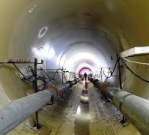
Case Study: Project in Poland Sets Fiberglass Pipe Jacking Record
- By Erin Boudreaux
- Dec 10, 2010
Poland’s Czajka Wastewater Treatment Works is currently being constructed on the riverbank of the Vistula River in Warsaw. After its completion, it will treat 80 percent of the Polish capital’s effluents and ensure that no more untreated sewage reaches the vegetation and wildlife along the Vistula.
Current estimates show that 30 percent of effluents have been flowing directly into the Vistula River, one of the longest and most important rivers in Poland. Warsaw is close to the environmentally fragile Baltic Sea and the Carpathian Mountains, home to the largest European population of brown bears.
Very much like the United States, Europe is challenged by the effort to upgrade its infrastructure. For example, in Poland more than 1,000 wastewater treatment plants must be built or upgraded to meet European standards taking effect in 2015. Warsaw, Poland’s largest city, is planning many upgrades, including a two-year project to provide added sewer capacity and decrease overflows.
The development plan includes a collector, now under construction, that leads to the plant. Because of this project’s size, it has been divided into three phases. The first is 3.5 miles of pipe jacking on the east side of the Vistula. The second is a 4,600-foot jack along the west bank. These pipelines will meet in the third section, the river crossing.
Centrifugally cast fiberglass reinforced polymer mortar (CCFRPM) pipe is being used for all three phases. They are the largest CCFRPM pipes made to date. Phases one and three will use 118-inch outside diameter (OD) pipes. The river crossing has two parallel 63-inch diameter lines installed in a 15-foot diameter concrete tunnel.

The group of contractors, Hydrobudowa 9, PRG Metro and KWG (all belonging to the PBG Group) completed the first pipeline section, which includes nearly a mile of jacking with two Herrenknecht microtunneling machines. Closeness to the river causes high groundwater with the typical water table just below the surface.
The contractor made quick work of one of the project’s major challenges, helped by the smooth and precise outer surface of the centrifugally cast fiberglass pipe. The original plan included a 2,800-foot section to be jacked from both ends and meet in the middle. However, because they were using CCFRPM pipe, the plan could be changed to jacking from one side only.
The separator processed 76 tons of soil per hour to keep up with the tunneling that averaged nine feet per hour. There was a cycle time of 40 to 60 minutes between pipes to allow for disassembly and reassembly of electric cables, slurry pipes, and hydraulic hoses. This allowed for an average of 10 pipes to be installed daily. The rapid production made it possible to install the first section of pipe weeks ahead of schedule.
The contractor followed the project plan even though the friction forces were so low, and installed an intermediate jacking station (IJS) every 328 feet, but only the last was used. The longest single drive involved two shifts working 24 hours per day and seven days a week. After it was completed, the intermediate stations were replaced by CCFRPM manholes and the IJS were reused elsewhere on the project.
Trenchless technology was specified for two challenges: the river crossing and because the pipeline route runs beneath a six-lane road. This is where a single drive of nearly 3,000 feet set a new record for the longest single drive on the project. Several impressive jacking runs included in the project set a global record for the longest fiberglass pipe jacking installation of 118-inch pipe.
Labor savings made it possible to use the CCFRPM pipe, which was not the low priced pipe for the project. For example, soil extraction was reduced by 30 percent because of the high strength, thin-walled product that has a smaller OD for the same inner diameter. Lighter construction equipment was required and its smaller size was a better fit for the tight space. Fast assembly, long service life, and low maintenance requirements were all part of the cost analysis.
About the Author
Erin Boudreaux is a marketing manager at HOBAS Pipe USA. She earned a bachelor's degree in marketing and a master's degree in business administration from Texas Tech University.